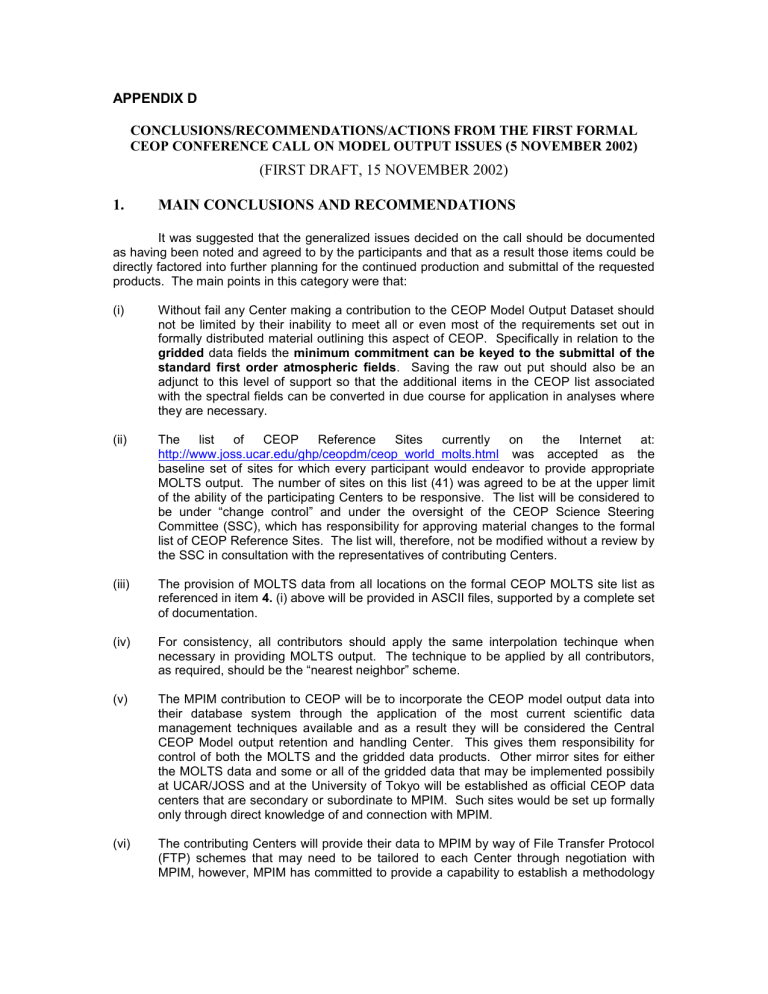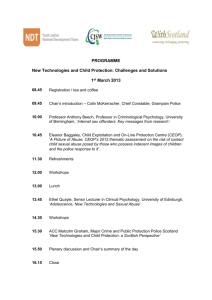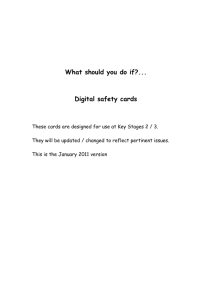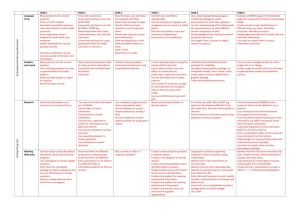APPENDIX D CONCLUSIONS/RECOMMENDATIONS/ACTIONS FROM THE FIRST FORMAL

APPENDIX D
CONCLUSIONS/RECOMMENDATIONS/ACTIONS FROM THE FIRST FORMAL
CEOP CONFERENCE CALL ON MODEL OUTPUT ISSUES (5 NOVEMBER 2002)
(FIRST DRAFT, 15 NOVEMBER 2002)
1. MAIN CONCLUSIONS AND RECOMMENDATIONS
It was suggested that the generalized issues decided on the call should be documented as having been noted and agreed to by the participants and that as a result those items could be directly factored into further planning for the continued production and submittal of the requested products. The main points in this category were that:
(i) Without fail any Center making a contribution to the CEOP Model Output Dataset should not be limited by their inability to meet all or even most of the requirements set out in formally distributed material outlining this aspect of CEOP. Specifically in relation to the gridded data fields the minimum commitment can be keyed to the submittal of the standard first order atmospheric fields . Saving the raw out put should also be an adjunct to this level of support so that the additional items in the CEOP list associated with the spectral fields can be converted in due course for application in analyses where they are necessary.
(ii) The list of CEOP Reference Sites currently on the Internet at: http://www.joss.ucar.edu/ghp/ceopdm/ceop_world_molts.html
was accepted as the baseline set of sites for which every participant would endeavor to provide appropriate
MOLTS output. The number of sites on this list (41) was agreed to be at the upper limit of the ability of the participating Centers to be responsive. The list will be considered to be under “change control” and under the oversight of the CEOP Science Steering
Committee (SSC), which has responsibility for approving material changes to the formal list of CEOP Reference Sites. The list will, therefore, not be modified without a review by the SSC in consultation with the representatives of contributing Centers.
(iii) The provision of MOLTS data from all locations on the formal CEOP MOLTS site list as referenced in item 4.
(i) above will be provided in ASCII files, supported by a complete set of documentation.
(iv) For consistency, all contributors should apply the same interpolation techinque when necessary in providing MOLTS output. The technique to be applied by all contributors, as required, should be the “nearest neighbor” scheme.
(v) The MPIM contribution to CEOP will be to incorporate the CEOP model output data into their database system through the application of the most current scientific data management techniques available and as a result they will be considered the Central
CEOP Model output retention and handling Center. This gives them responsibility for control of both the MOLTS and the gridded data products. Other mirror sites for either the MOLTS data and some or all of the gridded data that may be implemented possibily at UCAR/JOSS and at the University of Tokyo will be established as official CEOP data centers that are secondary or subordinate to MPIM. Such sites would be set up formally only through direct knowledge of and connection with MPIM.
(vi) The contributing Centers will provide their data to MPIM by way of File Transfer Protocol
(FTP) schemes that may need to be tailored to each Center through negotiation with
MPIM, however, MPIM has committed to provide a capability to establish a methodology
for getting or “pulling” data from a Center, if preferred, as well as receiving data “pushed” from a Center, as applicable.
(vii) The provision by MPIM as noted in their submitted documentation, which states that
“data are expected as time series of individual 2D variables. Each level is treated separately and each time series is stored in one GRIB file” was concurred on to be too restrictive and inefficient to be complied with by the contributing Centers. An ulternative approach/concept is required for this aspect of data handling.
(viii) The set of water and energy budget equations introduced in earlier CEOP Water and
Energy Simulation and Prediction (WESP) Working Group documentation upon which
CEOP requirements for varibles for calculating water and energy budgets are based, should be standardized and included for distribution in all relevant CEOP documentation.
The list of equations should be made consistent with those submitted in Appendix D,
Annex 1 of the ECMWF document, which describes the vertically integrated budgets used for their suite of output products. It was noted that in addition to vertical integrals, the total set of CEOP equations will also reflect the CEOP WESP effort to examine the vertical structure of the water and energy budgets
(xi) The need for continued dialog on these issues was confirmed and the concept of periodic conference calls was settled on as the means for this interaction. The next call will be undertaken on Tuesday 17 December 2002, at the same time.
2. MAIN ACTIONS/COMMITMENTS
Specific actions are required to ensure continued evolution of this aspect of CEOP. It is hoped that the actions will encourage further dialog among the contributing Centers and will work to increase momentum toward introduction of methodologies in response to CEOP needs leading to the maximum contributions possible within existing and otherwise available resources.
The list of actions that became evident at the time of the call and in discussions since, include:
(A1) Benedict accepted action A1 to further integrate existing inputs into the CEOP Model
Output Guidence Document and to maintain centralized coordination of further inputs and update to that CEOP documentation. The latest version of the Document is included with this Report. The changes include a revision of the attachements with the Appendixes now having the written inputs from Cent ers and the new list of “budget” equations.
(A2) Marengo (CPTEC), Puri (BMRC), Bosilovich (DAO) and Peters-Lidard (GLDAS) were asked to undertake action A2 to provide a written response dealing with the specific contribution that each of their Centers/Groups will make to the CEOP Model Output dataset, as specified in the current Guidence Document as attached. It is felt that with the information sent out before the call, the discussion on the call and the enclosed document containing inputs from other Centers there is sufficient background material to make such declarations of support as complete as possible.
(A3) All Model Output Center Spokespersons (Viterbo, Mitchell, Marengo, Puri, Bosilovich,
Peters-Lidard, Milton, and Nakamura) agreed to ( action A3 ) provide a list of parameters and units that they would include specifically with their MOLTS output. The list is to be sent to Steve Williams at UCAR ( sfw@ucar.edu
; http://www.joss.ucar.edu/ ).
In the ensuing discussion it was felt that even though different models have different vertical it would be useful to adopt a common unit/sign convention for the submitted variables.
AT the time of the call it was suggested that the GRIB units and GRIB sign conventions be adopted as reflected in the GRIB-1 standards framework.
(A4) As a result of the discussion on sign/units standards Peters-Lidard and Williams agreed to examine the lists of MOLTS variables and units that are to be provided by each Center spokesperson (See Action A3, above) and to undertake action A4 to investigate the extent to which the ALMA convention could be applied to the MOLTS variables. This might be restricted to surface quantity names and units.
(A5) All Model Output Center Spokespersons (Viterbo, Mitchell, Marengo, Puri, Bosilovich,
Peters-Lidard, Milton, and Nakamura) should accept action A5, to begin sending
MOLTS output already in production to MPIM for central handling/retention. The contact points for questions or issues regarding the transfer of these data are Burkhardt Rockel
( Burkhardt.Rockel@gkss.de
) and Michael Lautenschlager ( lautenschlager@dkrz.de
).
(A6) Rockel accepted action A6 , to continue working with Lautenschlager to further clarify the capabilities and nature of the contribution by MPIM to be the CEOP model output central retention and handling facility within the context of the current documentation and the discussions at the time of the conference call, espeically to address the issue of handling the data as specified in their current description of capabilities that deals with the form in which data are expected (See item 4. (vii) above, which identifies the quote in question: “data are expected as time series of individual 2D variables. Each level is treated separately and each time series is stored in one GRIB file”).
(A7) Roads agreed to ( action A7 ) work with Benedict to ensure that the relevant formulations in the total set of 3-D equations in the CEOP WESP Major Activities Plan and other applicable CEOP documentation were consistent with the ECMWF vertically integrated equations, provided in the ECMWF statement of their contribution to CEOP.







